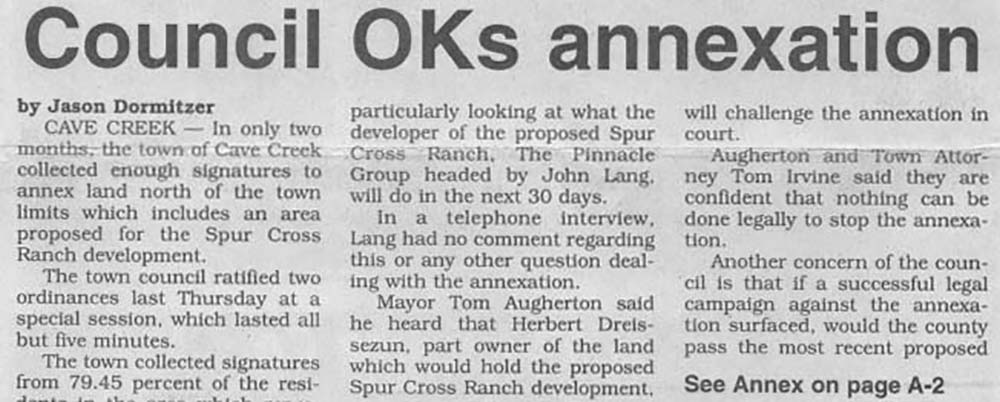25th Anniversary: Spur Cross retrospective
( Editor’s note: As we continue our retrospective on the incredible 42-month effort to save Spur Cross, we will focus on water which is one of the key elements identified in the last article by Gary Schmitt. Gail Clement was most generous in explaining three separate issues with respect to water, one of which Schmitt referred to as a silver bullet. Clement is a well known environmental scientist and water expert, having spent her career working with major corporations during which she gained an extensive knowledge base with respect to environmental regulations).
When the Spur Cross development threatened the area before she had even moved to their property here, she made a clear decision to do everything she could to save Spur Cross, often working 40 hour weeks in that effort. New construction was rampant in an era where development received broad support. Technical issues had to be addressed; some could be addressed with workarounds, some had teeth. Water had teeth.
The 3 major water issues were these:
~Impact on the creek itself (what can be put into the creek and what disturbance of the natural conditions can be allowed).
~Water supply to the households (developers need a guaranteed 100 year potable water supply for each project that is physically, continuously and legally available). This was the silver bullet.
~Water for the golf course (there was no approval from the Dept. of Water Resources for groundwater extraction and no proven sources of renewable supplies).
Senator John McCain was instrumental in alerting everyone he thought might lend support to the effort to save Spur Cross, including Governor Jane Hull, Secretary of Dept. the Interior Bruce Babbit, Commanding General of the U. S. Army Corps of Engineers Lt. Gen. Joe Ballard, Administrator of the EPA Carol M. Browner, Secretary of the U.S. Dept. of Agriculture Dan Glickman and Forest Supervisor Charles R. Bazan. Gary Schmitt initially made contact with the U.S. Army Corps of Engineers. McCain followed through for Friends of Spur Cross.
Regarding the impacts to the creek, the Spur Cross development required a site specific National Pollutant Discharge and Elimination System (NPDES) permit and an individual Army Corp of Engineers 404 permit under the Clean Water Act. This entailed an enormous effort, both time and expense on the part of the developer.
Because there had been two earlier developments attempted on the Spur Cross site, various arrangements for aggregating sufficient potable water had been made. Whether or not prior allocations made by the Cave Creek Water Company would transfer to the new development was in question and remained unresolved. The remaining unallocated Cave Creek Water Company supply was insufficient to guarantee the required 100 year water supply for the development.
In an attempt to secure the necessary additional water supply, the developer sought additional Central Arizona Project (CAP) water. The Berniel Water Company, a private water company serving portions of Paradise Valley, was interested in selling its CAP allocation. Transfer of the CAP allocation required approval from the Dept. of Water Resources and rules governing the transfer enabled adjacent water suppliers to intercede if they wanted the supply for themselves. The City of Scottsdale was always interested in increasing its CAP allocation and was alerted by Clement regarding the pending transfer. The result was the allocation provided to the developers fell short of the required supply.
The Colorado River Indian Tribes, the Hopi Tribe and others were approached. The Colorado River Indian Tribes were marketing their excess CAP water. The developers were interested in that supply for golf course irrigation. There were many difficult issues that complicated the provision of that water to Spur Cross. The ones that made the difference were the Tribes offered 99 year contracts, short of the 100 year guarantee that was necessary and the CAP canal was not capable of conveying the water continuously, particularly during high demand periods (summer). We will revisit the Tribes along the way with respect to other issues.
This is a greatly simplified explanation of an extremely complex multi-tiered situation in an era when it was rare to have a development shut down. It not only crippled the Spur Cross development but it also gave people fighting other developments hope and a guide to follow.
The Town of Cave Creek made quite a remarkable effort, according to Clement, to whom I owe an apology for misspelling her name in our last segment.
The Town of Cave Creek led by Mayor Tom Augherton and Councilman David Phelps pursued annexation of the area north of town, including Spur Cross Ranch because without the success of that effort, the town had little power in this critical fight.
Stay Tuned!












